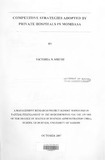| dc.description.abstract | Creating new forms of competitive advantage has become a major area of concern for management as the competitive environment continues to change rapidly and unpredictably. Organizations have had to undertake strategy formulation and implementation amidst many challenges the most critical being competition. Today’s managers are under pressure to improve productivity, quality and speed in their organizations. Porter (1998) argues that today’s dynamic markets and technologies called into question the sustainability of competitive advantage. Even where there has been operational improvements, rarely has these gains resulted into sustainable profitability. Yet organizations have to ensure they remain competitive amidst all the dynamics of the market. Therefore, organizations have to choose unique and valuable competitive strategies rooted in the systems and activities that are much more difficult to match; the competences have to be distinct.
Competition in any industry arises due to similarity in the products or services aimed at the same customer group. This applies even in the healthcare industry. Their principle product is providing medical services to their patients. This industry can be divided into private and public healthcare institutions both of which may target the same customers. It is in the light of competition that the different players strategize in order to outsmart their rivals, not just to continue existing but also to make profits. The nature and degree of competition in an industry hinge on five forces: the threat of new entrants, the bargaining power of buyers, the bargaining power of suppliers, the threat of substitute products or services, and the jockeying among current contestants (Porter, 1979). To establish a strategic agenda for dealing with these contending currents and to grow despite them, an organization must understand how they work in its industry and how they affect the organization in its particular situation. Porter’s five forces framework can be used to analyze the sources of competition in the healthcare industry, as they very much apply in this sector. | en |

